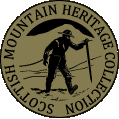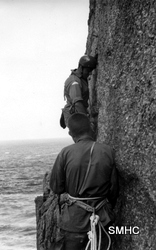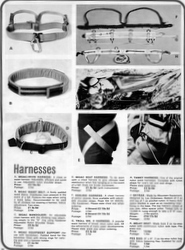
The Scottish Mountain Heritage Collection
Objects Database
MOAC/IRVIN Waistbelt
Accession Number
1244.2015.1
Object Name
MOAC/IRVIN Waistbelt
Created
08/05/2015
Creator
Hermione Cooper
Accession Date
08/05/2015
Brief Description
Yellow webbing waistband with metal buckle,leather piton pouch and two ice axe holsters
Materials
webbing, leather, metal
Dimensions
100(l) x5(w) cms
Number Of Objects
1
Inscription Description
"SKIDMORE" handwritten in ink on waistband
Colour
yellow, brown, green
Provenance
Since the inception of mountaineering as a sport in the early 1860's mountaineers had simply tied the rope around their waist when attaching themselves to the end of it and that was pretty much the way it was done until the 1950/60's when mountaineers/climbers finally realised that a big fall with a single rope round your waist could have serious consequences; there are many harrowing tales of folk being seriously injured and dying as a consequence.
An early method of 'spreading the load' was to wrap a length of hemp rope around the waist (usually six times) and then attach it to the main climbing rope by means of a karabiner.
The invention of nylon tape/webbing in the 1960's gave manufacturers a simple and effective method of creating a waist harness that would spread the impact of a fall and UK based companies such as Troll and MOAC were quick to capitalise on the new technology.
What we have here in the collection is an early MOAC waist belt (circa 1970) which has been customised by its previous owner, Bill Skidmore, with homemade ice axe holsters and an old camera case which he probably carried pitons in. An excellent 'wee' example of harness evolution.
Many thanks to Bill's widow, Mary Henery, who kindly donated some of his gear when he passed away in 2015.
Acquisition Method
Donated by Mary Henery
Acquisition Date
08/05/2015
Condition Check Date
08/05/2015
Rules
Spectrum : UK Museum documentation standard, V.3.1 2007
Modified
08/05/2015


